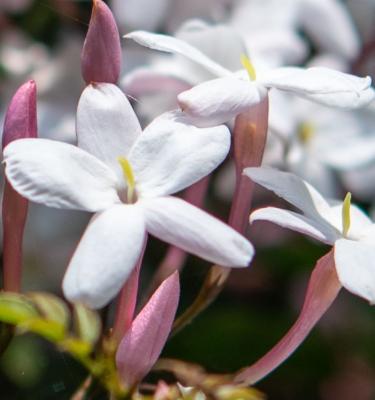

How to grow & care for jasmine
Jasmine (Jasmine polyanthum) is a vigorous vine with sweetly scented white and pink blushed blooms throughout spring and summer. Jasmine prefers full sun or part shade spot in moist, rich and well-drained soil. It will grow in most climates of Australia, however in some regions, it is considered a weed, so check with your local authority before planting.
If Jasmine polyanthum isn’t suitable in your area consider other sweetly scented jasmines including; Chinese Star Jasmine (Trachelospermum jasminoides), Common Jasmine (Jasminum officinale) or Arabian Jasmine (Jasminum sambac).
Jasmine looks beautiful grown up over an archway, up a trellis to hide a wall or even over a patio. It will happily grow in large pots if provided with a support structure.
Top 5 steps to growing jasmine
- Choose a full sun to part shade spot
- Jasmine prefers a soil rich in organic matter. Mix Scotts Osmocote® Compost Premium Soil Improver through the soil before planting.
- Provide a sturdy support, trellis or archway for the jasmine to climb up as it grows.
- Keep its vigorous growth in check with regular cut backs after flowering
- Check if Jasmine (Jasmine polyanthum) is a weed in your area before planting, if it’s not suitable choose another Jasmine species or consider Chinese Star Jasmine (Trachelospermum jasminoides)
Shopping List
- Jasmine plant
- Scotts Osmocote® Compost Premium Soil Improver
- Scotts Osmocote® Controlled Release Fertiliser: Roses, Gardenias, Azaleas & Camellias
- Garden Shovel
- If growing in pots, you’ll need Scotts Osmocote® Premium Potting Mix + Scotts Osmocote® Controlled Release Fertiliser for Pots, Planters and a suitable pot or container
- Garden Shovel
- Mulch
- Defender™ Pyrethrum Insect Spray
Preparation
Jasmine prefers a moist, yet free draining soil that has been enriched with organic matter. Before planting prepare the soil by mixing through Scotts Osmocote® Compost Premium Soil Improver and Scotts Osmocote® Controlled Release Fertiliser: Roses, Gardenias, Azaleas & Camellias.
To avoid disturbing your jasmines roots after planting, make sure you’ve got the trellis, archway or support structure set up before planting.
Planting in the garden
Plant your jasmine into prepared soil - dig the hole twice as wide as the original pot and the same depth. Gently remove the jasmine from the nursery pot and tease the roots lightly if they’re compact.
Plant into the hole and backfill around the plant. Water in well. Mulch around the base of jasmine to retain moisture and suppress weeds, but keep the mulch away from the main stem.
Planting in pots
Jasmine can be grown in large pots or planters with good drainage, choose a pot that is about 3 times the size of the original nursery pot. You can always repot it to a larger one as it grows.
Position the pot up against the support structure, archway or trellis for the jasmine to climb.
Fill your pot or planter with Scotts Osmocote® Premium Potting Mix. Gently remove the jasmine from the nursery pot and tease the roots lightly if they are compact. Plant the jasmine into the potting mix and backfill around the plant. Water in well and mulch over the surface of the potting mix to help retain moisture, but keep the mulch back from the plants main stems.
Fertilising & Care
Jasmine vines are very easy going and won’t need anything more than an annual fertilise in early spring with Scotts Osmocote® Controlled Release Fertiliser: Roses, Gardenias, Azaleas & Camellias to keep them happy.
Prune back after flowering to control their vigorous growth and cut off any suckers growing at the base of the plant.
Pests & Diseases
Jasmine is generally very pest and disease resistant. If aphids or scale do infest your jasmine vine - spray with Defender™ Pyrethrum Insect Spray as needed.



